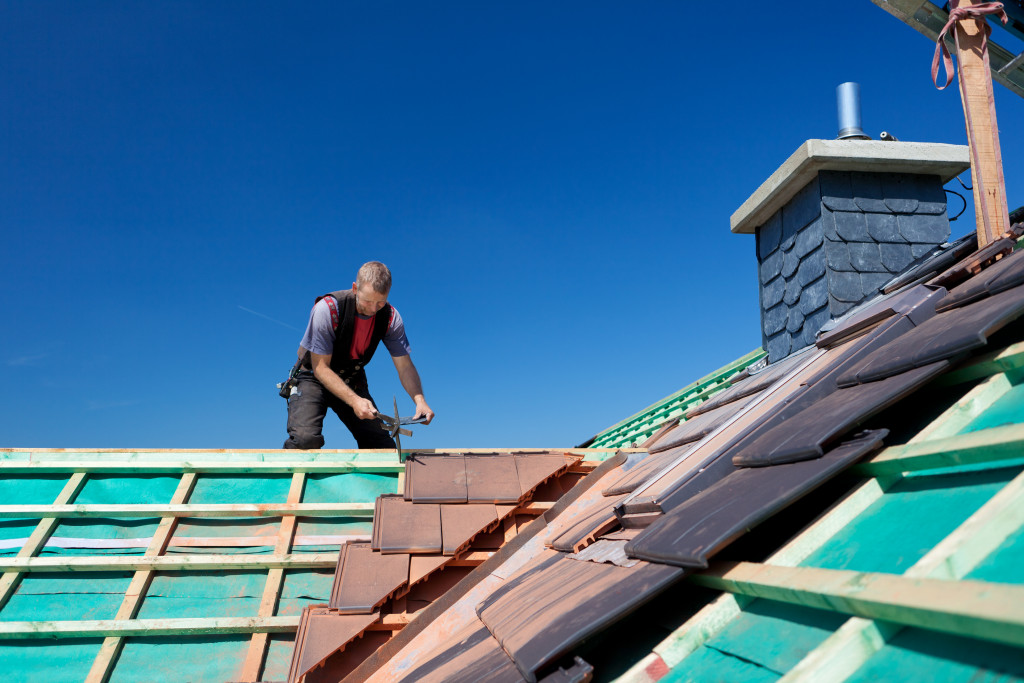It’s a sad fact of life that most homes will eventually suffer from some form of weather damage. Some people’s houses might be hit with hail, others may find themselves dealing with wind-blown rain and snow, while still, other homeowners may have to contend with a roof leak caused by heavy rainfall or melting ice. The good news is that there are many things you can do to help protect your home against these types of problems before they happen or even after they occur. In this article, we’ll look at a few ways you can strengthen the exterior of your house against weather damage.

1. Get a roofer to inspect the house for any leaks, cracks, or other damage
The roof of your home is its first line of defense against the elements. A well-maintained roof protects everything inside your house from rain, snow, wind, and sun damage. When the roof begins to show signs of wear and tear or simply doesn’t provide enough coverage for your home, costly problems can arise if left unrepaired.
If you’ve noticed that the roof of your house is starting to look worn or if you notice any spots where rainwater seems to be coming in, call a local professional to come out and check for leaks. When water enters your house, it can cause significant damage not only to the wood beams and joists that hold up your home but also to the insulation, wiring, and drywall on the interior. Also, be aware of any areas where there are rust stains or weird-looking patches on your roof. If you notice holes in your shingles or other signs that water might be coming into your home, get a professional out to assess the problem before it gets worse.
2. Get the sidings replaced every 10-15 years
The siding on your house can either help protect your home from the elements or work against it. By choosing material that is both durable and water-resistant, you might be able to prevent small problems like wind damage (which typically occurs when older wood siding gets dried out through exposure to repeated heating and cooling cycles) or even larger problems like water damage to the studs or insulation that may cause mold and rot.
In addition to looking at the type of siding you have on your house, also consider whether it’s been well maintained. Older houses especially can have issues with peeling paint or a surface layer of dirt that has trapped moisture in between the siding and the underlying wall, which can lead to rotting or warping. The best thing you can do is to contact siding contractors for replacement when necessary or simply give your siding a good scrubbing every couple of years with a power washer
3. Add downspouts on the outside of your home
While having downspouts that draw water away from the foundation of your house is important, it’s essential to extend them outside of the walls. If you notice that water seems to be pooling around the base of your house or along any part of its exterior, make sure you get downspouts installed as soon as possible.
4. Install gutters on all sides of your home’s exterior
Gutters work in conjunction with downspouts to keep water from pooling around your foundation or your exterior walls. While gutters are relatively inexpensive and easy to install on their own, they’re a lot less effective if not combined with the right type of downspouts. Make sure to clean your gutters and downspouts at least once per year to keep them functional.
5. Seal up any holes in walls with caulk or sealant
If you have any leaks in exterior walls, these can allow air to get inside your home during the winter months. If enough cold air seeps inside your house, it may be able to condense on cold surfaces like walls or windows. If this happens, ice will form and it will lead to water damage if the temperature rises and the ice melts. Caulking should be done to all cracks, holes, or joints on exterior walls. It should be applied in a continuous bead around the area to be caulked. The caulk is then smoothed over with a finger or paintbrush.
6. Replace old windows with double-paned models
Since the late 1970s, single-pane windows have been responsible for as much as 30% of heat loss from a home. If you’re not using double-paned windows, this is something that’s definitely worth looking into. Double-paned windows can also be more energy-efficient than single-paned windows, although this varies depending on the type of glass and how it was manufactured.
It’s important to take a holistic approach when trying to protect your home from weather damage. This may include replacing old siding, installing gutters and downspouts, caulking any holes in the exterior walls, and upgrading to double-paned windows. By taking these steps, you can help ensure that your home is better protected against the elements and less likely to suffer from water or wind damage.











